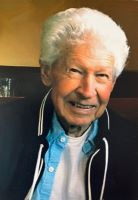
Ray Carlson Huffaker
Professor of Agronomy, Emeritus
Ray spent his early years on the family’s fish farm, the first in Utah, until the depression forced the sale of the farm. The family then moved to Oregon where his father farmed row crops. This influenced his interest in agriculture and plants. While in high school, he became interested in what the popular media called chemurgy, the application of chemistry to agriculture. This led Ray to take all available science courses. After graduating from high school, he enrolled at Brigham Young University furthering his passion for science and agriculture. He then entered UCLA for his graduate studies. There he became interested in the newly described fraction 1 protein, a protein in the leaves of plants that is more abundant than other cellular proteins. In fact, it is the most abundant protein on the planet, responsible for the fixation of CO2 by photosynthesis.
He utilized his chosen and cherished education in plant biology and biochemistry with fervor at UC Davis from 1960 to 1994 in the Department of Agronomy and Range Science. At Davis he continued his work on “fraction 1 protein” (ribulose bisphosphate carboxylase), elucidating the kinetics of its synthesis and degradation, especially during leaf senescence. Ray never hesitated to venture out into new research areas. He began work on the uptake and metabolism of nitrogen in plants, developing state of the art methods for determining the concentration of nitrate, nitrite and ammonia and using these methods to study the kinetics of uptake, cellular distribution and metabolism in leaves and roots of plants, shaping our understanding of these. During his career Ray published more than one hundred research papers and reviews on his research topics.
Ray was a compassionate and popular teacher at both the undergraduate and graduate levels. At the undergraduate level he taught in the biochemistry laboratory in the Biochemistry and Biophysics Department. He also stepped in on a temporary basis in agronomy courses when instructors were on sabbatical leave. Within 10 years of being at UC Davis, Ray’s research program had become highly visible to plant biologists, and he became a highly sought after major professor.
In graduate courses, Ray preferred private oral exams where he could clearly evaluate the students’ understanding of the subject matter. The most important lesson his graduate students learned under Ray’s mentorship was how to plan and execute a research program that would guarantee a successful career in academia or other research institutions.
A unique attribute of Ray’s was that his relationship with students and colleagues was not only professional but personal as well. Ray always showed interest in his students and other people working in his group, and got involved, if needed, in their personal lives to help them deal with any of their life problems. He knew how a person’s personal life affects their professional and academic performance. Ray considered everyone in his group as part of his family.
Ray was a member of the following professional societies: Society of Agronomy, Society of Sigma Xi, American Society of Plant Physiologists, Scandinavian Society of Plant Physiologists, Crop Science Society, and American Society of Biological Chemists.
Ray was also active in university service at the departmental and campus wide committees, among them, the Committee on Academic Personnel, and the Vice Chancellor Search committee. He was also appointed Director of the Plant Growth Lab in 1981.
After retirement he returned to Utah where he enjoyed his favorite pastimes, fishing, skiing, and golfing. As all good things end, Ray was afflicted with Alzheimer’s. As his health deteriorated, he still reminisced over the pleasures from his past, still enjoying the plants in his surroundings. His family, colleagues and friends miss his gentle humor and wisdom.
Bill BreidenbachBob Travis
Sham Goyal
